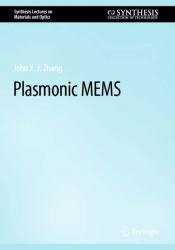Plasmonic MEMS
- Добавил: literator
- Дата: 23-01-2023, 05:00
- Комментариев: 0
 Название: Plasmonic MEMS
Название: Plasmonic MEMSАвтор: John X. J. Zhang
Издательство: Springer
Год: 2023
Страниц: 196
Язык: английский
Формат: pdf (true)
Размер: 10.2 MB
This book covers key topics in the emerging field of plasmonic MEMS, with an emphasis on practical aspects. Although readers can find many comprehensive textbooks on electromagnetic waves, nanophotonics and plasmonics, most of these lack the focus needed for a thorough grasp of plasmonic micromachining and MEMS.
This book introduces the main framework of plasmonic MEMS, providing an overview of introductory concepts, a thorough description of the basic foundations, along with the state-of-the-art and existing challenges. The author presents an abbreviated overview of the basic physics and devices related to electromagnetic waves and surface plasmons. Additional coverage includes recent advances in the fabrication of sub-100-nm patterns on micro scale devices and structures and a review of emerging techniques in the fabrication of plasmonic systems. A comprehensive and historical review of the current advances in the area of plasmonic nanofabrication is also included.
Micro-Electro-Mechanical Systems (MEMS) is the technology of integrated mechanical and electro-mechanical micro-elements on a single chip. The micro-scale moving components of MEMS devices can be readily and robustly fabricated using the well-developed micro/nano fabrication techniques. Mechanical displacement in MEMS devices can be obtained via external electrical actuation. MEMS technology aims to revolutionize nearly every product group by substituting sensors, actuators, detectors, and gears with micrometer-scale equivalents.
One of the main reasons for the development of MEMS technology in recent years, is the drastic reduction of the size of the device components along with the additional and complemented mechanical modulation functionality which can enable tunable on-chip sensors and actuators. MEMS can provide microstructures in a variety of desirable shapes and sizes with critical future size of micro or nano meter along with significant mechanical tunability.
The precision mechanics of MEMS technology and micromachining have ignited the possibility of using this technology for a wide variety of applications in high-speed digital circuits, radio frequency (RF) and Infrared (IR) devices, wireless communications and nanosatellites, unmanned air vehicles (UAVs), optical detectors, biomedical devices and imaging, to name a few.
Recent years have seen an exciting and gradually emerging field of “Plasmonic MEMS”, which attempts to combine plasmonics with Microelectromechanical System (MEMS) technology towards achieving remarkably enhanced system performance. Progress and improvements in Optical MEMS in the past two decades have led to a variety of miniaturized movable and tunable mirrors, lenses, filters, and other optical structures. Plasmonic MEMS provides a new set of perspectives and design tools through in-depth coupling of physics and chemistry at surfaces and interfaces with multi-scale engineering, which has great interdisciplinary appeal, attracting researchers from fields as diverse as electrical engineering, mechanical engineering, optics, biochemistry, biomedical engineering, and biology towards new system designs.
Our intention in creating this book is to cover the key topics in the emerging field of plasmonic MEMS, with the emphasis on the practical aspects of this area. Extended readings can be referred to many comprehensive and well-written textbooks on electromagnetic waves, nanophotonics, and plasmonics. However, most of these literatures are lengthy and lack the focus needed for thoroughly grasp on plasmonic micromachining and MEMS. This handbook is organized in six chapters that reflect the current status of the evolving scientific field.
This book focuses on an appealing and distinctive aspect of plasmonics, as a tool for patterning and the fabrication of ultra-fine resolution structures. The author reviews the recent developments in plasmonic MEMS and microsystems for biosensing applications, including refractive-index based label-free biosensing, plasmonic integrated lab-on-chip systems, plasmonic for near-field scanning optical microscopy (NSOM) and plasmonics on-chip system for cellular imaging.
Contents:
1. Introduction
2. Theoretical Foundations
3. Fabrication Techniques
4. Plasmonics as a Fabrication Tool
5. Plasmonic MEMS in Biosensing and Imaging
6. Summary and Future Perspectives
Скачать Plasmonic MEMS
Внимание
Уважаемый посетитель, Вы зашли на сайт как незарегистрированный пользователь.
Мы рекомендуем Вам зарегистрироваться либо войти на сайт под своим именем.
Уважаемый посетитель, Вы зашли на сайт как незарегистрированный пользователь.
Мы рекомендуем Вам зарегистрироваться либо войти на сайт под своим именем.
Информация
Посетители, находящиеся в группе Гости, не могут оставлять комментарии к данной публикации.
Посетители, находящиеся в группе Гости, не могут оставлять комментарии к данной публикации.
